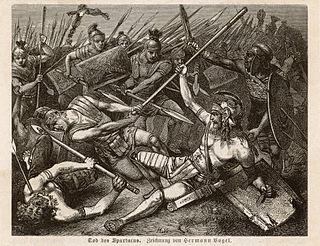See also
- List of military legions
- Roman Legion-Hare (1955 film) an animated short film featuring Bugs Bunny
Roman legion may refer to:
Legion may refer to:
The Roman legion was the largest military unit of the Roman army, composed of 4,200 infantry and 300 equites (cavalry) in the period of the Roman Republic ; and was composed of 5,200 infantry and 120 auxilia in the period of the Roman Empire.
Roman or Romans most often refers to:
Roma or ROMA may refer to:

The following outline is provided as an overview of and topical guide to ancient Rome:
Rome is the English form of the name of the capital city of Italy, and formerly capital of the Roman Empire and seat of the papacy, where it consistently has been called Roma.

The Roman legionary was a professional heavy infantryman of the Roman army after the Marian reforms. These soldiers would conquer and defend the territories of ancient Rome during the late Republic and Principate eras, alongside auxiliary and cavalry detachments. At its height, Roman legionaries were viewed as the foremost fighting force in the Roman world, with commentators such as Vegetius praising their fighting effectiveness centuries after the classical Roman legionary disappeared.

Legio XVIII was a legion of the Imperial Roman army. It was founded ca. 41 BC by the future emperor Augustus. The legion was, along with two others, destroyed in the Battle of Teutoburg Forest. The legion's symbol and cognomen are unknown.

A legatus was a high-ranking Roman military officer in the Roman Army, equivalent to a modern high-ranking general officer. Initially used to delegate power, the term became formalised under Augustus as the officer in command of a legion.

In historiography, ancient Rome describes Roman civilization from the founding of the Italian city of Rome in the 8th century BC to the collapse of the Western Roman Empire in the 5th century AD, in turn encompassing the Roman Kingdom, Roman Republic and Roman Empire until the fall of the western empire. The civilisation began as an Italic settlement in the Italian Peninsula, traditionally dated to 753 BC, that grew into the city of Rome and which subsequently gave its name to the empire over which it ruled and to the widespread civilisation the empire developed. The civilization was led and ruled by the Romans, alternately considered an ethnic group or a nationality. The Roman Empire expanded to become one of the largest empires in the ancient world, still ruled from the city, with an estimated 50 to 90 million inhabitants and covering 5 million square kilometres at its height in AD 117.

The Roman army was the armed forces deployed by the Romans throughout the duration of Ancient Rome, from the Roman Kingdom to the Roman Republic and the Roman Empire, and its medieval continuation, the Eastern Roman Empire. It is thus a term that may span approximately 2,205 years, during which the Roman armed forces underwent numerous permutations in composition, organisation, equipment and tactics, while conserving a core of lasting traditions.

The Third Servile War, also called the Gladiator War and the War of Spartacus by Plutarch, was the last in a series of slave rebellions against the Roman Republic known as the Servile Wars. This third rebellion was the only one that directly threatened the Roman heartland of Italy. It was particularly alarming to Rome because its military seemed powerless to suppress it.

A centurion was a position in the Roman army during classical antiquity, nominally the commander of a century, a military unit of around 80 legionaries. In a Roman legion, centuries were grouped into cohorts commanded by their senior-most centurion. The prestigious first cohort was led by the primus pilus, the most senior centurion in the legion and its third-in-command.
An ala was the term used during the middle of the Roman Republic to denote a military formation composed of conscripts from the socii, Rome's Italian military allies. A normal consular army during the period consisted of two legions, composed of only Roman citizens, and two allied alae.

Roman Syria was an early Roman province annexed to the Roman Republic in 64 BC by Pompey in the Third Mithridatic War following the defeat of King of Armenia Tigranes the Great.
The military engineering of Ancient Rome's armed forces was of a scale and frequency far beyond that of any of its contemporaries. Indeed, military engineering was in many ways institutionally endemic in Roman military culture, as demonstrated by each Roman legionary having as part of his equipment a shovel, alongside his gladius (sword) and pila (spears).

Spartacus was a Thracian gladiator who, along with Crixus, Gannicus, Castus, and Oenomaus, was one of the escaped slave leaders in the Third Servile War, a major slave uprising against the Roman Republic. Little is known about him beyond the events of the war, and surviving historical accounts are sometimes contradictory. All sources agree that he was a former gladiator and an accomplished military leader.
Roman infantry tactics refers to the theoretical and historical deployment, formation, and manoeuvres of the Roman infantry from the start of the Roman Republic to the fall of the Western Roman Empire.
First Legion may refer to: